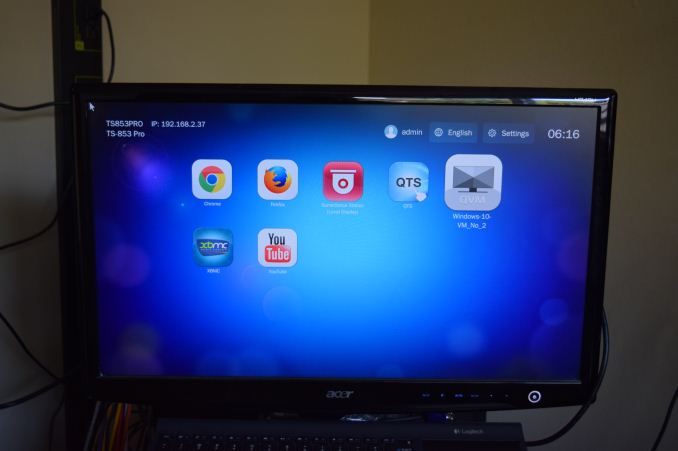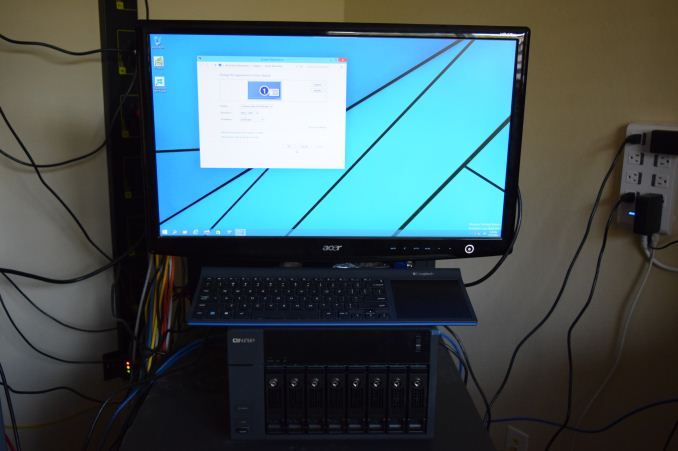QNAP TS-853 Pro 8-bay Intel Bay Trail SMB NAS Review
by Ganesh T S on December 29, 2014 7:30 AM ESTQNAP's HD Station - QvPC Explored
Over the last few years, QNAP has been introducing various interesting packages for their QTS operating system. XBMC was one of the first to take advantage of the HDMI display output on their NAS units. Slowly, a few other packages such as web browsers, NAS management interfaces and YouTube were introduced. Recently, QNAP decided to bundle all these packages under the Hybrid Desk Station (HD Station) moniker.
The ability to interact with the NAS using a keyboard and a mouse brought it closer to a traditional PC for the average consumer. Virtualization Station was the final piece in the puzzle. QNAP added an option to display the console of each VM on the display output desktop (a QVM option) in the Virtualization Station settings. This enables end users to interact not only with the QTS desktop, but also with a Windows or Ubuntu VM as if it was running on a physical machine.
QNAP's HD Station Interface with QVM Activated
Recognizing the big leap made in HD Station using QVMs, QNAP has opted to do a branding exercise - QvPC - for this feature set. In addition to QVMs, HD Station also includes a local output for the tracked surveillance cameras, XBMC with HD audio bitstreaming and other miscellaneous features. QNAP's product page for HD Station adds more marketing detail to what we have covered above.
Windows 10 on a QNAP TS-853 Pro-8G - QvPC
Our usual NAS evaluation routine doesn't load up the NAS with non-NAS aspects while processing benchmarks. For the TS-853 Pro-8G, we did one pass with all four network links bonded and no extra packages active. However, with running VMs being a very attractive feature of the TS-x53 Pro series, we added two sets of benchmarks for the multi-client scenarios after configuring two Windows 10 VMs (two cores, 2 GB RAM and one dedicated network link each). This configuration left the other two network ports free for bonding / external traffic. The CPU cores themselves had to be shared between the VMs and the main NAS tasks (as all four cores ended up getting allocated to the VMs).
- 1 QVM: A Windows 10 VM with QVM configured was activated. PC Mark 8's 'Work' workload was run in a loop with HDMI output enabled, while the rest of the NAS was subject to storage traffic over the bonded network links
- 2 VMs: QVM was de-activated. Two Windows 10 VMs were configured for access via Remote Desktop. PC Mark 8's 'Work' workload was run in a loop on both VMs, while the rest of the NAS was subject to storage traffice over the bonded network links.
In addition to the above Virtualization Station configuration, we also found an interesting caching aspect in QTS. Our benchmarks are processed after turning off the write cache (EXT4 delay allocation) for all NAS units. However, QTS, in addition to the EXT4 delay allocation, has an additional system cache setting at the volume level. The large amount of RAM in the system (8 GB) also skewed the results quite a bit with the system cache settings enabled. QNAP is also one of the first COTS NAS vendors to support SMB 3.0. Obviously, this is available only for Windows 8 and Windows Server 2012 R2 and later operating systems. We tested out SMB 3.0 with a Windows 8 VM in our NAS testbed. In the rest of the review, we try to address as many different combinations as possible in the benchmarks.












58 Comments
View All Comments
milkod2001 - Monday, December 29, 2014 - link
I could understand this unit to be used by business users who need to have ready to go solution, don't mind the cost,don't have enough IT skills or are not willing to pay IT Pro to get similar or better system build for less then half price.But for home users this is definitely overkill and price wise a madness. Would love to see more down to earth 2 - 4 bays NAS units reviewed, some roundup(4-5 options).
keep up good work guys, thanks
PaulJeff - Monday, December 29, 2014 - link
Agreed. The cost for something like this for even a home pro-user is insane. I would like to see Ganesh do a ZFS shootout based on price with FreeNAS (or similar). For the cost of these NASs, I can build a crazy fast ZFS NAS with SSD L2ARC and 4x 1Gbit NICs.I propose Anandtech/Ganesh do a DIY NAS comparison based on price and feature tiers.
nathanddrews - Monday, December 29, 2014 - link
All these COTS solutions seem so expensive for what you get - especially for the DIY portion of AT's readership. The obvious tradeoff is buying something functional from the start for a high price or spending a lot of time building something less expensive.A review/comparison of soft-RAID, home-build NAS/server devices would be nice, but understandably time consuming. Two or three tiers of hardware (Atom-class vs i-3-class vs Xeon-class), two or three tiers of OS (UnRAID, Windows Server/Windows 8.1, Stablebit DrivePool, FreeNAS), and then just a preset number of drives (four? eight?) for all of them.
PaulJeff - Monday, December 29, 2014 - link
I considered buying a FreeNAS Mini from IXSystems (FreeNAS OEM). I'm too lazy to request a quote, but I suspect that for what you get hardware-wise would be price competitive with what AT normally reviews.I do agree that, though time consuming, it would be well worth the effort to do a comprehensive DIY vs COTS NAS and with benchmarks to follow.
My FreeNAS box, (ASUS P9A-I, 16GB ECC RAM, 128GB SSD L2ARC and 6x 4TB HGST RAIDZ2), run cycles around most COTS NAS at half the price (minus HDD).
DanNeely - Tuesday, December 30, 2014 - link
Dunno why they have the request a quote option (maybe for business customers whose burrocrazy needs a PO instead of a number off the webpage?) because the pricing tab has actual prices. The FreeNAS Mini is $995 without disks and has prices for 4-24TB (pre-redundancy) configurations along with options for more ram and SSD caches.ap90033 - Friday, January 2, 2015 - link
That would be a useful Review!!!!Adrian3 - Monday, December 29, 2014 - link
I'll be buying one of these very soon for home use. Why do you think it's insane? I'll be populating it with eight 6TB Red drives - the cost of the unit is a fraction of the cost of the drives. I want something that is fast, can do transcoding, is metal instead of plastic, has a small footprint, low power usage and easy to set up. So, what's the alternative that fits those requirements?Morawka - Tuesday, December 30, 2014 - link
can these little baytrail units even do realy 1080p on the fly transcoding? i was under the impression that they were to slow for hi def content like for a plex server.Adrian3 - Tuesday, December 30, 2014 - link
Yes - definitely. Read the section "Real-time & offline HD video transcoding" on this page: http://www.qnap.com/i/uk/product/model.php?II=151nathanddrews - Tuesday, December 30, 2014 - link
I can tell you right now with 100% certainty that Bay Trail can't do that - it can barely transcode one stream, let alone five. They must have extra embedded silicon dedicated to the process - which explains some of the cost of the unit. Reading through the details, it seems obvious that they have a means for transcoding through the built in hardware:"Transcode Full HD videos on-the-fly or offline with QNAP’s unique transcoding technology. It allows for up to 5 devices to simultaneously view different videos stored on the TS-853 Pro with on-the-fly hardware accelerated transcoding.
1. Transcode video files to 240p, 360p, 480p, 720p and 1080p resolution
2. Automatic video transcoding for watched folders
3. Hardware accelerated transcoding support"